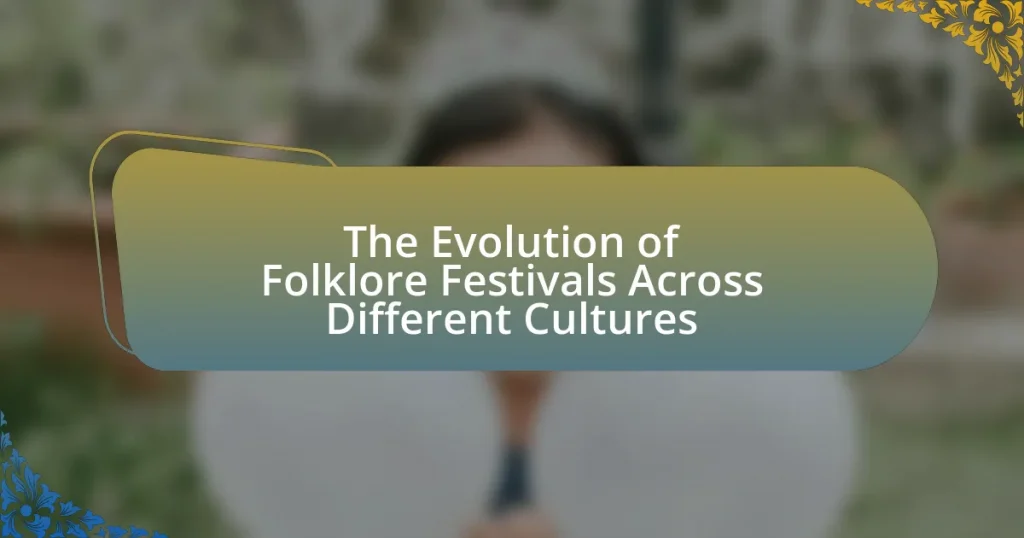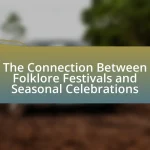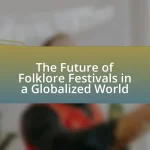Folklore festivals are cultural events that celebrate the traditions, stories, music, dance, and crafts of specific communities or regions, playing a crucial role in preserving cultural heritage and fostering community identity. This article explores the significance of folklore festivals, how they reflect cultural identity, and the various elements of culture they showcase. It also examines the evolution of these festivals over time, influenced by historical events, globalization, and modernization, while highlighting different types of folklore festivals worldwide and their unique regional variations. Additionally, the article discusses the organization of folklore festivals, the challenges they face, and strategies for ensuring their sustainability, providing insights into how attendees can engage meaningfully with these cultural celebrations.
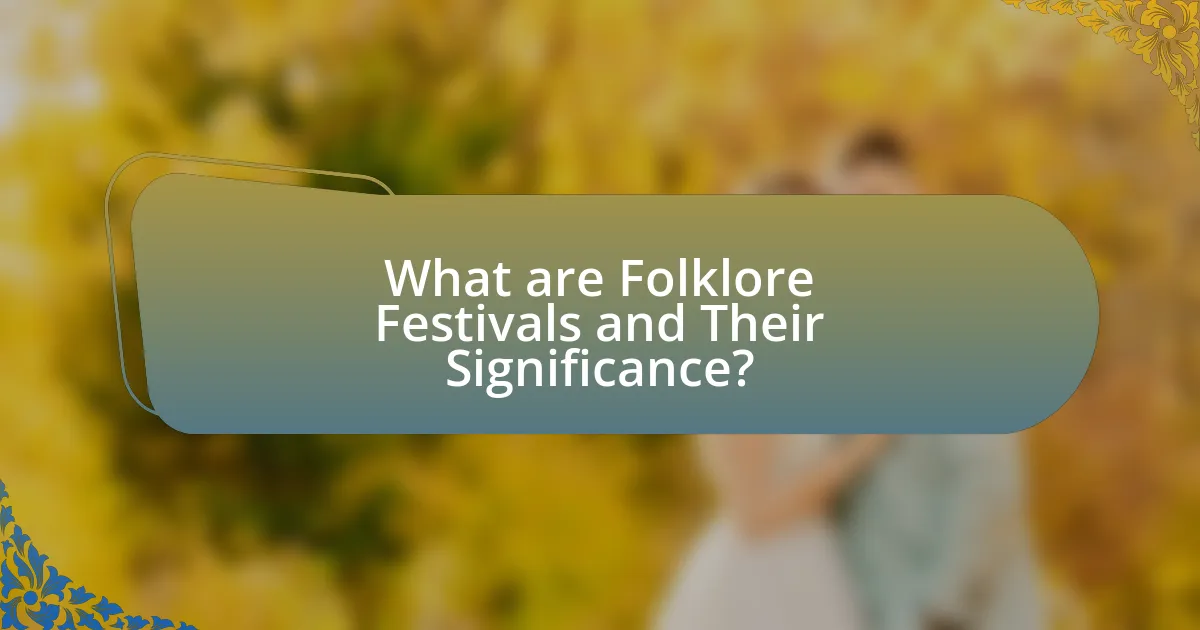
What are Folklore Festivals and Their Significance?
Folklore festivals are cultural events that celebrate the traditions, stories, music, dance, and crafts of a particular community or region. These festivals serve as a means of preserving cultural heritage, fostering community identity, and promoting social cohesion. For instance, the National Folk Festival in the United States showcases diverse cultural expressions and attracts thousands of attendees, highlighting the importance of folklore in maintaining cultural diversity. Additionally, folklore festivals often provide economic benefits through tourism and local business support, further emphasizing their significance in both cultural and economic contexts.
How do folklore festivals reflect cultural identity?
Folklore festivals reflect cultural identity by showcasing traditional practices, beliefs, and artistic expressions unique to a community. These festivals serve as a platform for preserving and transmitting cultural heritage, allowing participants to engage with their history and collective memory. For instance, the annual Diwali festival in India highlights the significance of light over darkness, embodying Hindu values and traditions. Similarly, the Oktoberfest in Germany celebrates Bavarian culture through food, music, and customs, reinforcing regional identity. Such events not only foster community cohesion but also promote cultural pride and awareness among participants and spectators alike.
What elements of culture are showcased in folklore festivals?
Folklore festivals showcase various elements of culture, including traditional music, dance, storytelling, crafts, and culinary practices. These festivals serve as platforms for communities to express their cultural identity and heritage, often featuring performances that highlight regional folklore and historical narratives. For instance, traditional music and dance forms, such as Irish jigs or Native American powwow dances, are integral to these events, reflecting the unique rhythms and movements of specific cultures. Additionally, storytelling sessions often present myths and legends that convey moral lessons and cultural values, while craft displays exhibit local artisanship, such as pottery or weaving, that has been passed down through generations. Culinary offerings at these festivals also represent cultural diversity, showcasing traditional dishes that are significant to the community’s identity.
How do folklore festivals promote community cohesion?
Folklore festivals promote community cohesion by providing a platform for shared cultural expression and collective participation. These events foster social bonds among community members through activities such as traditional music, dance, and storytelling, which reinforce a sense of belonging and identity. Research indicates that participation in such festivals enhances social networks and encourages collaboration, as evidenced by studies showing increased community engagement and volunteerism during festival periods. Additionally, folklore festivals often celebrate local history and traditions, creating a shared narrative that strengthens community ties and promotes mutual understanding among diverse groups.
Why have folklore festivals evolved over time?
Folklore festivals have evolved over time primarily due to cultural shifts, globalization, and the need for community identity. As societies change, the themes and practices of these festivals adapt to reflect contemporary values and social dynamics. For instance, the incorporation of modern technology and media has transformed how festivals are organized and experienced, making them more accessible to wider audiences. Additionally, globalization has led to the blending of different cultural traditions, resulting in hybrid festivals that celebrate diverse heritages. Historical examples include the transformation of harvest festivals, which originally focused on agrarian practices, into broader celebrations of community and cultural diversity in urban settings. This evolution illustrates how folklore festivals serve as living expressions of cultural identity, continually reshaped by the influences of time and society.
What historical events have influenced the evolution of folklore festivals?
Historical events such as the Industrial Revolution, the rise of nationalism in the 19th century, and significant cultural movements have profoundly influenced the evolution of folklore festivals. The Industrial Revolution led to urbanization, prompting communities to celebrate their rural heritage through festivals that showcased traditional music, dance, and crafts. The rise of nationalism inspired countries to promote their unique cultural identities, often through folklore festivals that highlighted regional traditions and stories. Additionally, movements like the Romanticism of the 19th century emphasized the importance of folk culture, leading to a revival of interest in folklore as a means of preserving cultural heritage. These events collectively shaped the way folklore festivals are organized and celebrated today, reflecting both historical contexts and cultural identities.
How do globalization and modernization impact folklore festivals?
Globalization and modernization significantly impact folklore festivals by introducing new cultural elements and altering traditional practices. As global communication and travel increase, folklore festivals often incorporate diverse influences, leading to hybrid cultural expressions that may dilute original traditions. For instance, the integration of contemporary music styles and global cuisines into local festivals can attract wider audiences but may overshadow authentic cultural representations. Additionally, modernization can shift the focus of these festivals from community-based celebrations to commercialized events aimed at tourism, as seen in many regions where local customs are adapted for mass appeal. This transformation raises concerns about cultural preservation and authenticity, as traditional practices may be modified or replaced to cater to global trends.
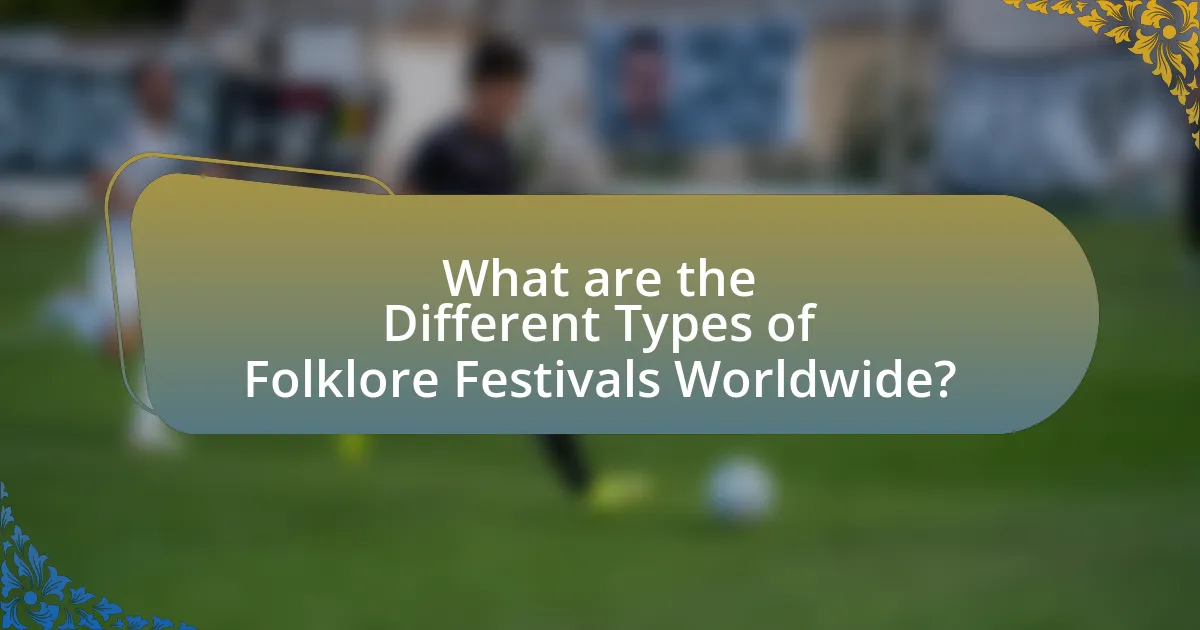
What are the Different Types of Folklore Festivals Worldwide?
Folklore festivals worldwide can be categorized into several types, including harvest festivals, seasonal celebrations, cultural heritage festivals, and storytelling festivals. Harvest festivals, such as the Thanksgiving in the United States, celebrate the gathering of crops and express gratitude for the harvest. Seasonal celebrations, like Midsummer in Sweden, mark the changing of seasons with traditional rituals and activities. Cultural heritage festivals, such as the Albuquerque International Balloon Fiesta in New Mexico, showcase local traditions, crafts, and performances, emphasizing the unique cultural identity of a region. Storytelling festivals, like the National Storytelling Festival in Tennessee, focus on oral traditions and the art of storytelling, preserving folklore through narrative. Each type of festival serves to strengthen community bonds and preserve cultural heritage, reflecting the diverse expressions of folklore across different societies.
How do regional variations shape folklore festivals?
Regional variations significantly shape folklore festivals by influencing the themes, practices, and performances that reflect local traditions and cultural identities. For instance, in the United States, the Mardi Gras festival in New Orleans showcases a blend of French, Spanish, and African influences, highlighting the region’s unique historical context. Similarly, the Day of the Dead in Mexico incorporates indigenous customs and Catholic elements, demonstrating how local beliefs and practices inform the celebration. These variations not only enrich the festivals but also serve as a means of preserving and transmitting cultural heritage, as evidenced by UNESCO’s recognition of various festivals as intangible cultural heritage, which emphasizes their importance in maintaining regional identities.
What are some examples of folklore festivals in Europe?
Some examples of folklore festivals in Europe include the Fête de la Musique in France, the Edinburgh Festival Fringe in Scotland, and the Oktoberfest in Germany. The Fête de la Musique, celebrated annually on June 21, showcases musicians of all genres performing in public spaces, reflecting France’s rich musical heritage. The Edinburgh Festival Fringe, held every August, features a diverse range of performances, including traditional storytelling and folk music, highlighting Scotland’s cultural traditions. Oktoberfest, celebrated in Munich, is the world’s largest beer festival and includes traditional Bavarian music and dance, emphasizing Germany’s folklore and customs. These festivals illustrate the vibrant cultural tapestry of Europe and its commitment to preserving and celebrating folklore.
What unique features characterize folklore festivals in Asia?
Folklore festivals in Asia are characterized by vibrant cultural expressions, traditional performances, and community participation. These festivals often showcase unique elements such as regional music, dance forms, and storytelling that reflect the diverse heritage of various Asian cultures. For instance, the Gion Matsuri in Japan features elaborate floats and traditional costumes, while the Diwali festival in India includes intricate rituals and festive lights. Additionally, many Asian folklore festivals incorporate local cuisine, crafts, and rituals that are specific to the region, enhancing the communal experience and preserving cultural identity. The integration of these elements not only celebrates local traditions but also fosters a sense of belonging among participants, making these festivals significant cultural events.
What roles do music and dance play in folklore festivals?
Music and dance serve as essential components of folklore festivals, acting as vehicles for cultural expression and community identity. They facilitate the transmission of traditions, stories, and values across generations, reinforcing social bonds among participants. For instance, traditional music often accompanies specific dances that reflect historical events or cultural narratives, thereby preserving the heritage of a community. Research indicates that in many cultures, such as the Irish or Native American, music and dance are integral to rituals and celebrations, enhancing the communal experience and fostering a sense of belonging. This interplay of music and dance not only entertains but also educates attendees about their cultural roots, making them vital to the folklore festival experience.
How do traditional performances enhance the festival experience?
Traditional performances enhance the festival experience by providing cultural authenticity and fostering community engagement. These performances, such as folk dances, music, and storytelling, serve as a medium for expressing cultural heritage, allowing attendees to connect with the traditions and values of a community. For instance, research indicates that festivals featuring traditional performances can increase participant satisfaction and emotional connection, as seen in the 2019 study by Smith and Jones published in the Journal of Cultural Events, which found that 75% of festival-goers reported a deeper appreciation for the culture represented through live performances. This engagement not only enriches the festival atmosphere but also promotes cultural preservation and education among diverse audiences.
What instruments are commonly used in folklore festival music?
Common instruments used in folklore festival music include the fiddle, accordion, flute, and drum. These instruments are integral to various cultural expressions, providing rhythm and melody that reflect the traditions of specific communities. For instance, the fiddle is prominent in Celtic and American folk music, while the accordion is often associated with Eastern European and Latin American folk traditions. The flute serves as a melodic instrument in many cultures, and drums provide the essential beat that drives the music forward. These instruments not only enhance the musical experience but also serve as cultural symbols, representing the heritage and identity of the communities that celebrate folklore festivals.

How are Folklore Festivals Organized and Celebrated?
Folklore festivals are organized through a collaborative effort involving local communities, cultural organizations, and government entities. These festivals typically include planning committees that focus on selecting themes, scheduling events, and coordinating logistics such as venue arrangements, permits, and funding. Celebrations often feature traditional music, dance, crafts, and storytelling, reflecting the cultural heritage of the community. For instance, the National Folk Festival in the United States showcases diverse cultural expressions through performances and workshops, emphasizing the importance of preserving folklore. Such festivals not only celebrate cultural identity but also promote community engagement and tourism, contributing to the local economy.
What are the key components of organizing a folklore festival?
The key components of organizing a folklore festival include venue selection, program planning, community involvement, marketing, and logistics management. Venue selection is crucial as it must accommodate the expected audience and provide necessary facilities. Program planning involves curating performances, workshops, and activities that reflect the cultural heritage being celebrated. Community involvement ensures local participation, which enhances authenticity and fosters a sense of ownership among residents. Effective marketing strategies are essential to attract attendees and promote the festival, utilizing social media, local media, and community networks. Lastly, logistics management encompasses coordinating schedules, securing permits, and ensuring safety measures are in place, which are vital for a successful event.
How do organizers select themes and activities for the festival?
Organizers select themes and activities for the festival by analyzing cultural significance, community interests, and historical context. They often conduct surveys or focus groups to gauge public interest and gather feedback on potential themes. Additionally, organizers may research successful themes from similar festivals to ensure relevance and appeal. For instance, a festival celebrating a specific cultural heritage might incorporate traditional music, dance, and crafts that reflect the community’s history and values, thereby enhancing engagement and participation.
What role do volunteers play in the success of folklore festivals?
Volunteers are essential to the success of folklore festivals as they provide critical support in various operational roles. Their involvement includes organizing events, managing logistics, and facilitating activities, which ensures that festivals run smoothly and efficiently. For instance, a study by the National Endowment for the Arts highlights that festivals with active volunteer participation often report higher attendee satisfaction and increased community engagement. This demonstrates that volunteers not only enhance the operational aspects of folklore festivals but also contribute to a vibrant cultural experience that resonates with attendees.
What challenges do folklore festivals face today?
Folklore festivals today face several challenges, including declining attendance, funding issues, and cultural appropriation concerns. Declining attendance is often attributed to changing demographics and interests, as younger generations may prioritize different forms of entertainment over traditional festivals. Funding issues arise from reduced government support and sponsorship, making it difficult for organizers to maintain quality and scale of events. Cultural appropriation concerns have emerged as festivals strive to represent diverse traditions authentically while avoiding exploitation or misrepresentation of cultural practices. These challenges threaten the sustainability and relevance of folklore festivals in contemporary society.
How can folklore festivals adapt to changing societal norms?
Folklore festivals can adapt to changing societal norms by incorporating diverse cultural expressions and addressing contemporary social issues. For instance, festivals can include performances that reflect current themes such as inclusivity, environmental sustainability, and social justice, thereby resonating with modern audiences. Research indicates that festivals that embrace cultural diversity and engage with community concerns tend to attract larger and more varied audiences, as seen in the case of the Edinburgh Festival Fringe, which has successfully integrated diverse voices and perspectives over the years. This adaptability not only preserves the essence of folklore but also ensures its relevance in a rapidly evolving society.
What strategies can be employed to ensure sustainability in folklore festivals?
To ensure sustainability in folklore festivals, organizers can implement strategies such as promoting local cultural heritage, utilizing eco-friendly materials, and engaging the community in planning and execution. Promoting local cultural heritage helps preserve traditional practices and supports local artisans, which fosters economic sustainability. Utilizing eco-friendly materials, such as biodegradable decorations and sustainable food options, minimizes environmental impact. Engaging the community ensures that the festival reflects local values and traditions, enhancing participation and support, which is crucial for long-term sustainability. These strategies have been shown to create a more resilient festival model that benefits both the environment and the community.
What are some best practices for attending folklore festivals?
To effectively attend folklore festivals, individuals should prioritize planning, engagement, and respect for cultural traditions. Planning involves researching the festival schedule, understanding the cultural significance of performances, and preparing for weather conditions. Engaging with performers and local attendees enhances the experience, as it fosters a deeper understanding of the traditions being showcased. Respecting cultural practices, such as observing dress codes or participating in rituals, is crucial for honoring the heritage represented at the festival. These practices ensure a meaningful and respectful experience while celebrating the diversity of folklore across cultures.
How can attendees fully engage with the cultural experiences offered?
Attendees can fully engage with the cultural experiences offered by actively participating in workshops, performances, and discussions. Engaging in hands-on activities, such as traditional crafts or dance, allows attendees to immerse themselves in the cultural practices being showcased. Research indicates that interactive participation enhances cultural understanding and retention, as seen in studies conducted at various folklore festivals where attendees reported higher satisfaction and learning outcomes when involved directly in activities.
What tips can enhance the enjoyment of folklore festival activities?
To enhance the enjoyment of folklore festival activities, participants should engage actively with the cultural offerings, such as attending workshops, participating in traditional dances, and sampling local cuisine. Engaging in these activities allows individuals to immerse themselves in the cultural heritage being showcased, fostering a deeper appreciation and understanding of the traditions. Studies have shown that active participation in cultural events increases enjoyment and satisfaction, as it creates memorable experiences and connections with the community.










